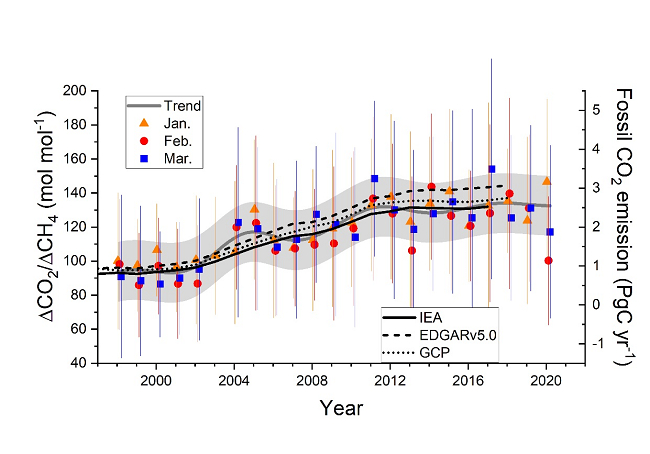Decrease in fossil-fuel CO2 emissions due to COVID-19 detected by atmospheric observations
Synoptic CO2 variations decreased at Hateruma Island, Japan, during February-March 2020

Tracking emissions of anthropogenic greenhouse gases by atmospheric observations is a major challenge for policymaking, such as the Paris Agreement. Huge atmospheric observation networks comprised of a variety of platforms including satellites have been developed to monitor regional/country-scale changes in the anthropogenic greenhouse gas emissions. The outbreak of the new coronavirus (COVID-19) has been affecting the global socio-economic activity, leading to a significant reduction in fossil-fuel-derived CO2 (FFCO2) emissions and other anthropogenic air pollutants in the world. This situation gave us a unique opportunity to assess our ability to quantify the changes in the regional FFCO2 emissions using atmospheric observations. However, there are few reports of observational evidence for CO2 emission reduction due to the COVID-19 lockdown, although a large number of publications have reported reductions in short-lived air pollutants from various parts of the world.
In Scientific Reports by Nature Publishing, researchers from the National Institute for Environmental Studies (NIES), Japan, and the Japan Agency for Marine-Earth Science and Technology (JAMSTEC) analyzed atmospheric CO2 and CH4 concentrations observed at Hateruma Island, Japan, which is located in the continental margin of East Asia, and detected signals related to the FFCO2 reduction in China caused by the restrictions associated with the COVID-19 outbreak in January-March 2020.
We estimated that the FFCO2 emissions decreased by about 20% during January-February 2020 as a result of the measures to prevent the spread of COVID-19 within China and to the outside world. While a significant reduction of the atmospheric pollutants has been reported, papers on the atmospheric signals of the FFCO2 reduction are yet to be found in the published literature. “The size of the atmospheric reservoir of CO2 is quite large and the atmospheric CO2 has a relatively long lifetime. These characteristics make the change in the atmospheric CO2 concentrations caused by the COVID-19 influence quite small”, stated Prabir K. Patra, co-author of the study and researcher at JAMSTEC.
To detect such faint signals in the CO2 variations, the research team of NIES and JAMSTEC focused on the relative variation of the atmospheric CO2 and CH4 observed at Hateruma Island for the past 20 years at daily time intervals. “The atmospheric observation at Hateruma Island is often influenced by the continental emissions during winter due to the airflow pattern caused by the East Asian monsoon. We know that the temporal variations in the atmospheric CO2 and CH4 concentrations show considerable similarity, and the temporal change in the ratio of CO2 to CH4 variations trace very well the temporal change in fossil-fuel emissions in China for the years before 2020”, said Yasunori Tohjima, lead author of the study and researcher at NIES. “Thus the variation ratio of CO2 to CH4 was expected to detect the signal reflecting the change in the continental CO2 emissions related to COVID-19 restrictions.”
The research team found that the monthly average ratio of the atmospheric CO2 to CH4 variations in January, February, and March tracked the yearly increase in FFCO2 emissions from China during 1997-2019. However, the ratios showed significant decreases in February and March 2020, which coincided with the lockdown period in China. “The relationship between the variation ratio and the FFCO2 emissions from China should be evaluated by using an atmospheric transport model and a set of CO2 and CH4 flux maps”, said Yosuke Niwa, co-author of the study and researcher at NIES. “We used multiple simulations of atmospheric CO2 and CH4 at Hateruma Island for various emission reduction scenarios of fossil-fuel CO2 by using NICAM-TM.” The study thus concluded that China’s FFCO2 emissions decreased by about 30% in February and about 20% in March 2020. “Our approach presented in this study has the potential to detect signals from the emission reduction from any specific region in near-real-time using continuous and high-precision measurements of CO2 and CH4”, mentioned Prabir K. Patra.

Contacts
Contact Person:Yasunori Tohjima
Release URL:
Journal:
Scientific Reports
DOI:
10.1038/s41598-020-75763-6
Full names of funders:
Environment Research and Technology Development Funds (JPMEERF20172010, JPMEERF20172001) from the Environmental Restoration and Conservation Agency).
Research funds by Global Environmental Research Coordination System from the Ministry of the Environment, Japan (FY2014, FY2019).
- What's New
- What's New 2024
- What's New 2023
- What's New 2022
- What's New 2021
- What's New 2020
- What's New 2019
- What's New 2018
- What's New 2017
- What's New 2016
- What's New 2015
- What's New 2014
- What's New 2013
- What's New 2012
- What's New 2011
- What's New 2010
- What's New 2009
- What's New 2008
- What's New 2007
- What's New 2006
- What's New 2005
- What's New 2004
- What's New 2003
- What's New 2002
- Event Information
- Visit NIES